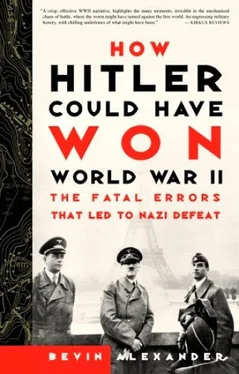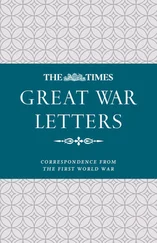Nevertheless, British and French armies persisted in spreading most of their tanks among their infantry divisions. Both remained under the delusion that battles would be fought all along a continuous line, and they could move tanks and guns to block any point where a few enemy tanks achieved a breakthrough. They did not understand the effect of massing large numbers of tanks for a decisive penetration at a single point.
The radical aircraft the Germans developed was not much to look at. It was the Junker 87B Stuka, a dive-bomber with nonretractable landing gear, an 1,100-pound bombload, and a top speed of only 240 mph. It was already obsolete in 1940, but the Stuka (short for Sturzkampfflugzeug, or “dive battle aircraft”) was designed to make pinpoint attacks on enemy battlefield positions, tanks, and troops. And, since the German Luftwaffe (air force) gained air superiority quickly with its excellent fighter the Messerschmitt 109, the Stuka had the sky over the battlefield largely to itself. The Stuka functioned as aerial artillery and was highly effective. It also was terrifying to Allied soldiers because of its accuracy and because German pilots fitted the Stuka with an ordinary whistle that emitted a high-pitched scream as it dived. The Allied air forces had not seen a need for such a plane and concentrated primarily on area bombing, which was much less effective on the battlefield.
When German panzers broke through enemy lines, they could employ both their own organic artillery and Stukas to shatter enemy positions or assist motorized infantry in attacks. It was a new way to win tactical engagements, and the Allies had nothing to match it.
2 THE CAMPAIGN IN THE WEST: 1940

GERMANY’S ORIGINAL PLAN FOR THE ATTACK IN THE WEST WAS ASTONISHINGLY modest. It aimed at no decision. It didn’t even anticipate a victory over France.
The initial proposal, produced on Hitler’s orders by the Oberkommando des Heeres (OKH), or army command, in October 1939, hoped merely to defeat large portions of the Allied armies and gain territory in Holland, Belgium, and northern France “for successful air and sea operations against Britain and as a broad protective zone for the Ruhr” industrial region east of Holland.
The plan resembled superficially the famous Schlieffen plan of World War I in that the main weight of the attack was to go through Belgium. Beyond that, the OKH’s plan was utterly different. Count Alfred von Schlieffen had intended to defeat the entire French army. His aim was to outflank Allied forces with a wide right hook that drove down southwest of Paris, then turned back and pushed—from the rear— the entire enemy army up against the Franco-German frontier, compelling it to surrender.
None of this was possible in 1940. In 1914 Schlieffen had counted on strategic surprise. In 1940 the Allies anticipated the Germans would come through Belgium because a direct attack across the French frontier was impossible. In the 1930s France had constructed the Maginot Line from Switzerland to Luxembourg, a barrier of interconnected reinforced concrete fortifications and casemated cannons that could not be overcome by a direct attack.
Once the Germans tipped their hand, the Allies intended to throw forward strong forces to meet the Germans in Belgium, though it was the wrong thing to do. The sensible course would be to remain in already prepared defenses along the Belgian frontier, or withdraw to the Somme River fifty miles south, form a powerful defensive line, take advantage of the Allies’ two-to-one superiority in artillery, and launch a counterstroke against the exposed southern flank of the Germans as they drove westward. The Allies might shatter the German army by such a move. Even if they didn’t, they would still be dug in and ready for an attack when and where it came.
But France had suffered great devastation in World War I and did not want to fight the next war on French soil. Also, the British and French hoped to gain the help of the Belgian and Dutch armies. With them, the Allies would have as many soldiers as the Germans. They expected to use the Dyle, a north-flowing river some fifteen miles east of Brussels, as the main defensive barrier, sending their most mobile forces forty miles farther east to the Meuse (Maas) River to slow the German advance.
The Allied leaders downplayed the glaring weakness of this plan. It required their main forces to abandon already built fortifications along the frontier, move rapidly to the Dyle, and dig a new defensive line in the two or three days they were likely to have before the Germans arrived.
OKH saw the Allied disadvantages and hoped German forces could break through the two river lines with powerful frontal assaults. But the Allies, even if defeated, might still retreat behind the lower Somme, and form a continuous front with the Maginot Line. That is why Hitler and the OKH didn’t expect a total victory in the west. They anticipated a stalemate, the same condition the Germans had to accept at the end of the autumn battles in 1914. The only improvement would be that the coast of northern France, Belgium, and Holland would be available to pursue a naval and air war against Britain.
When Erich von Manstein saw the plan he declared that it would be a crime to use the German army for a partial victory, leading to a long war of attrition. It would mean defeat, since the Allies, with control of the seas and access to unlimited resources from Asia, Africa, and America, had much greater capacity to win a long war than the Germans.
Manstein was chief of staff to Gerd von Rundstedt, commander of Army Group A, and he saw an opportunity that had escaped the OKH— a way to eliminate the Allies’ entire northern wing after it rushed into Belgium. This same move would open the door to a second campaign that could destroy the remainder of the French army.
With Rundstedt’s approval, Manstein proposed that the main weight of the German attack be shifted to Army Group A and the Ardennes, a heavily forested region of low mountains in eastern Belgium and northern Luxembourg. He advocated that the vast bulk of Germany’s ten panzer divisions be concentrated there to press through to Sedan on the Meuse River, cross it before a substantial French defense could be set up, then turn westward and drive through virtually undefended territory to the English Channel. This would cut off all the Allied armies in Belgium and force them to surrender.
Manstein urged that a major decoy offensive still should be launched into northern Belgium and Holland under Army Group B, commanded by Fedor von Bock. Bock’s armies should make as much noise as possible to convince the Allies that the main effort was coming just where they expected it. This would induce them to commit most of their mobile forces to Belgium. The farther they advanced, the more certain would be their destruction.
“The offensive capacity of the German army was our trump card, and to fritter it away on half-measures was inadmissible,” Manstein wrote.
Manstein asked Heinz Guderian whether tanks could negotiate the hills and narrow roads of the Ardennes. Guderian studied the terrain, replied yes, and became an ardent apostle of Manstein’s plan.
But the OKH did not, and stonewalled for the next three months. Walther von Brauchitsch, commander of the Germany army, and Franz Halder, chief of the army staff, did not like the idea of their plan being tossed out, and they did not share Manstein and Guderian’s enthusiasm for tanks. They thought like orthodox soldiers and believed crossing a major stream such as the Meuse required moving up infantry and artillery, and a carefully worked-out coordinated assault. This would take time, time the French could use as well to build a strong defensive line.
Читать дальше



![Джонатан Димблби - Barbarossa - How Hitler Lost the War [calibre]](/books/385421/dzhonatan-dimblbi-barbarossa-how-hitler-lost-the-w-thumb.webp)









